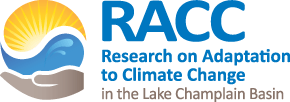by
Betts, A.K., R. Desjardins, D. Worth and B. Beckage (2014)
This analysis uses over 50 years of hourly observations of temperature, relative humidity, and opaque cloud cover and daily precipitation from 11 climate stations across the Canadian Prairies to analyze the monthly, seasonal and long-term climate coupling in the warm season. On climate timescales, temperature depends on cloud forcing, while relative humidity depends on precipitation. The monthly climate depends on both opaque cloud cover for the current month and precipitation for both the present and past 2 months in summer. Multiple linear regression shows that anomalies of opaque cloud and precipitation explain 60-80% of the variance in the diurnal temperature range, afternoon relative humidity and lifting condensation level on monthly timescales. We analyze the internal coupling of diurnal climate observables as a further guide to evaluating models. We couple the statistics to simplified energy and water budgets for the Prairies in the growing season. The opaque cloud observations have been calibrated against the incoming shortwave and longwave fluxes. We estimate that the dry-down of total water storage on the landscape damps 56% of precipitation anomalies for the growing season on large spatial scales, although this drydown increases evapotranspiration. This couples the climatological surface fluxes to four key observables: cloud forcing, precipitation, temperature and humidity. We estimate a climatological evaporative fraction of 0.61 for the Prairies. The observational relationships of the coupled Prairie climate system across timescale will be useful for evaluating these coupled processes in models for weather and seasonal forecasting and climate simulation.
Although it is on the fringe of RACC, this paper (the fourth in an on-going series) is developing a deeper understanding of land-surface climate coupling. Traditionally hydrometeorology was based on temperature and precipitation: the addition of the radiative forcing of the surface by clouds and the addition of RH to the mix is helping us understand the fully coupled system across timescales.
https://alanbetts.com/research/paper/climate-coupling-between-temperatur...
